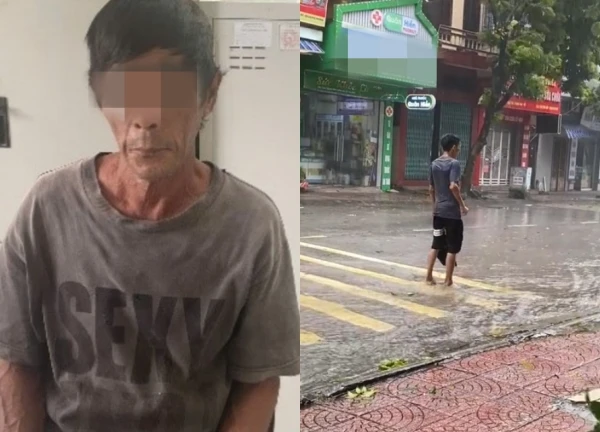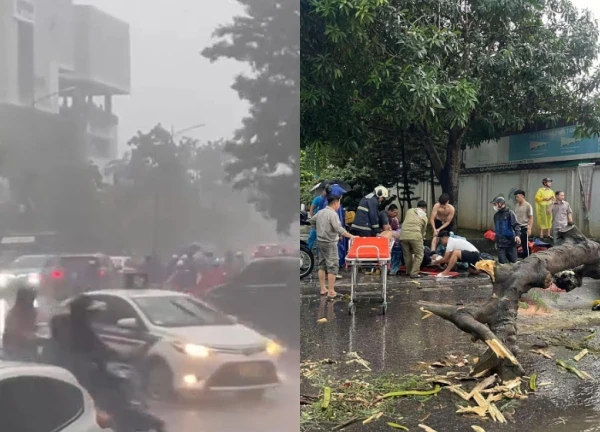Revealing the family circumstances of the Lieutenant who died when fighting Typhoon Yagi, mourning the message of his young wife

2 | 1 Discuss | Share
The strongest historical super typhoon in the past 30 years has just swept the entire North, causing heavy damage that everyone is terrified of. Looking back at the images after the storm, everyone has to be sad and terrified by the devastation of natural disasters.
When the dawn of September 7 has just dawned, people in the northern coastal provinces have prepared themselves to face the strongest storm in 3 decades - Yagi. Starting from the South China Sea, the super storm headed directly into the Gulf of Tonkin with wind gusts of level 13-14. Not long after, Quang Ninh and Hai Phong became the first points to suffer the wrath of nature.
At 10 a.m. on September 7, the Quang Ninh estuary was hazy and could not see the horizon, the sea waves soared, hitting the faces of fishermen who were still lingering in the Ha Long fishing wharf market. On the seaside route, there are only a few motorbikes rushing to the shelter. Just a few minutes later, they realized that the recommendation of the authorities to "not stay on the boat" was well-founded. Typhoon Yagi made landfall with terrible winds. The wind hissed one by one, gusting as if it was about to sweep people away. The boat of 2 couples sank right at the edge of the port, is 1 of 25 boats sunk due to the storm in Quang Ninh, according to authorities statistics.
During Typhoon Yagi, standing on the shore to watch your boat sink is sometimes lucky. At Mong Cai, the fishing boat was broken and drifted away, there was still a fisherman on the boat who could not jump ashore.
Inside Ha Long city, corrugated iron roofs could not withstand the wind blowing around, screaming on the asphalt pavement. After the corrugated iron, it was the turn of the glass doors of the building to be swept away by the wind. The draft wind through the window crevices creates terrible screaks.
Quang Ninh province, with about 2 decades of "transformation" in infrastructure, has just undergone an unprecedented test of the durability of iconic buildings.
Within a few hours, the charcoal-black glass panes of the Quang Ninh Museum were shattered by the storm. On the other side of the square, the "Dolphin Palace" - the most unique architectural block in the city - was also torn off the aluminum roof by the wind.
While the storm swept through Quang Ninh, the people of Hai Phong also felt the fierce wind. On the afternoon of September 7, the Hai Phong Department of Transport issued a ban on vehicles passing through Binh Bridge, Hoang Van Thu Bridge, Kien Bridge, Tan Vu - Lach Huyen Bridge and Ben Rang Bridge.
Along Nguyen Huu Cau street (the main road of the district), trees and billboards were broken and falling down. Notably, many metal lampposts were also knocked down by the wind due to many advertising boxes and decorations hanging on the poles...
By the afternoon of the same day, electricity was cut off in many places in Hai Phong city. Telephone and internet waves were also disrupted.
"Before the storm, I also had preparations, cleaned up my goods, and leaned against the door. However, the power of the storm is too great, beyond my imagination and that of everyone," Ms. Huong, the owner of a costume rental shop in Do Son, shared. Her shop was blown off the roof by the storm, tearing off the rolling door.
After sweeping through the coastal provinces, Typhoon Yagi continued to cause a lot of damage in Hai Duong, Hung Yen and then landed in the capital Hanoi.
Previously, when the storm had not yet entered, Hanoi recorded people who died because trees fell after a thunderstorm. When the storm came, the whole city was strewn with broken trees, and one more person died because they were crushed by trees.
At noon on September 7, all public transportation in Hanoi including trains and buses stopped operating.
By the afternoon of September 7, the people of the capital began to feel the terrible wind from the storm. Although it has friction with the land and significantly reduced its level, the wind force of the storm is still too resistant to trees and many infrastructure works in the capital.
Due to the influence of thunderstorms, rain and storms on the evening of September 7, some places in Hanoi experienced widespread power outages. In which, the 110kV power grid has 12 lines that have jumped faults, only one 110kV Xuan Mai substation lost power, handled right on the night of September 7, dawn on September 8.
In the city, a number of level 4 houses were knocked down by the storm. Apartment residents also encountered many incidents such as ceiling collapse, glass doors opened, rainwater spilled into the house... According to statistics, the storm knocked down 24,800 trees in Hanoi, causing 4 deaths and 17 injuries.
Xuan Bac went to the street to clean up with his 2 children after Typhoon Yagi, doing something that everyone appreciated  Pinky09:07:44 09/09/2024Typhoon Yagi landed in Hanoi from the evening of September 7 with widespread devastation. A series of trees were knocked down, lying paralyzed on the road, greatly affecting traffic and people's lives.
Pinky09:07:44 09/09/2024Typhoon Yagi landed in Hanoi from the evening of September 7 with widespread devastation. A series of trees were knocked down, lying paralyzed on the road, greatly affecting traffic and people's lives.

2 | 1 Discuss | Share

2 | 1 Discuss | Share

4 | 1 Discuss | Share

1 | 1 Discuss | Share

4 | 1 Discuss | Share

1 | 1 Discuss | Share

1 | 1 Discuss | Share

2 | 1 Discuss | Share

1 | 1 Discuss | Share

1 | 1 Discuss | Share

2 | 1 Discuss | Share





2 | 1 Discuss | Report